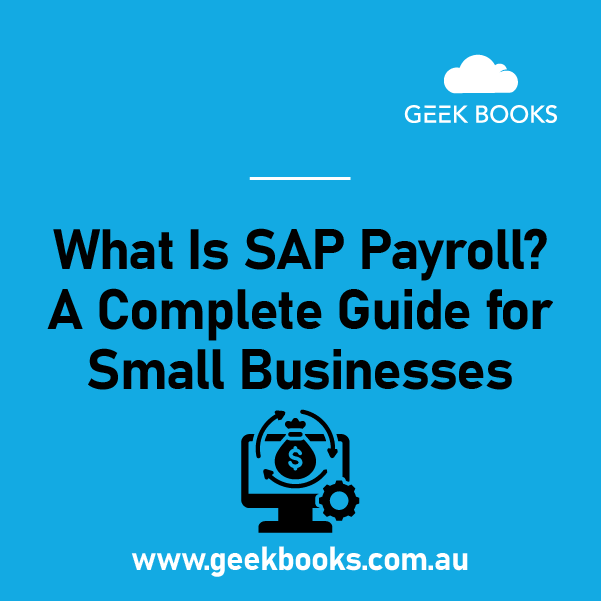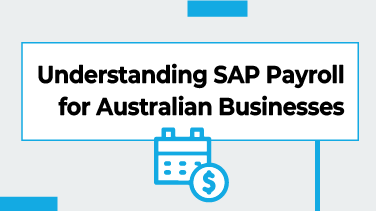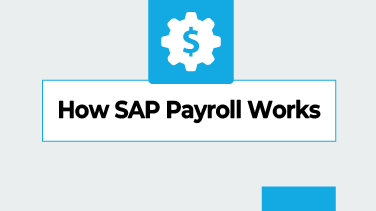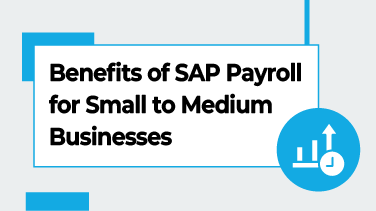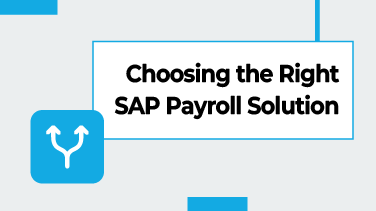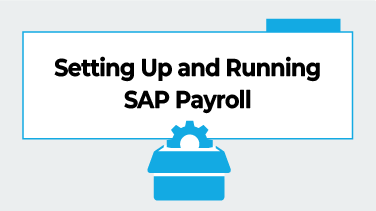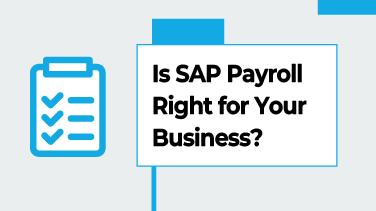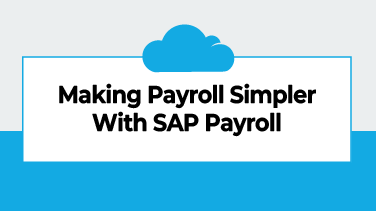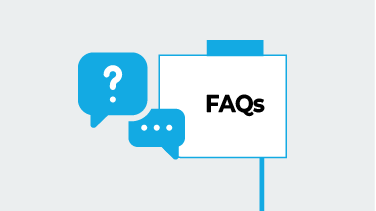Imagine running payroll without errors, late payments, or compliance worries.
Just accurate, on-time pay runs—every time.
That’s the promise of SAP Payroll—a powerful, automated payroll system designed to take the stress out of managing employee wages.
For Australian small businesses, SAP Payroll handles everything from calculating salaries and deducting taxes to ensuring your business stays compliant with Fair Work and ATO regulations.
In this guide, we’ll break down exactly how SAP Payroll works, the key benefits it offers, and how to decide if it’s the right fit for your business.
Understanding SAP Payroll for Australian Businesses
Tired of juggling spreadsheets and chasing compliance?
SAP Payroll is your all-in-one solution for accurate, stress-free payroll—available in the cloud or on-premise.
From wages and taxes to superannuation and ATO reporting, it handles payday with ease.
What makes SAP Payroll stand out? Seamless integration.
It syncs with your HR, finance, and time management systems, so employee hours, leave balances, and pay details update automatically—no more double data entry.
Designed for small to medium Australian businesses, SAP Payroll is fully compliant with local legislation and ATO requirements.
Stay efficient, compliant, and focused on growing your business.
Say goodbye to payroll stress and hello to peace of mind.
How SAP Payroll Works
Automating Payroll Calculations and Payments
At the heart of SAP Payroll is automation—it takes care of your entire salary process.
From calculating tax to superannuation payments, SAP Payroll systems make each pay cycle smooth and stress-free.
Here’s how it typically works:
- Enter or sync employee data – wages, hours worked, leave balances, etc.
- The system runs calculations – automatically applies PAYG tax, super, allowances, and deductions.
- Review and approve – preview the payroll run and confirm it’s accurate.
- Finalise payments – salaries are paid, super is distributed, and payslips are sent.
- Compliance reporting – STP reports are submitted to the ATO in real time.
By automating each step, SAP Payroll cuts down on manual work, reduces errors, and saves valuable time.
In fact, businesses that use automated payroll systems experience 67% fewer errors on average, making a strong case for ditching spreadsheets and switching to smarter tech.
Ensuring Compliance with Australian Tax and Superannuation Laws
Keeping up with tax rules and superannuation obligations can be a full-time job—but with SAP Payroll, compliance is built in.
The system automatically calculates:
- PAYG tax
- Superannuation contributions
- Award-based pay rates and entitlements
It also supports Single Touch Payroll (STP), which means your business can report tax and super info to the ATO instantly, every time you run payroll.
Manual payroll processing can lead to costly errors, including underpayments, missed super, or late tax lodgements—issues that can result in fines, penalties, and employee disputes.
With SAP Payroll, you get peace of mind knowing your payroll is always on the right side of the law.
Integrating with HR and Time Management Systems
SAP Payroll systems don’t operate in a silo—it integrates with your other business systems for a truly connected experience.
By linking with:
- HR software like SAP SuccessFactors
- Time-tracking tools to capture hours worked and leave
- Finance platforms for accurate budgeting and reporting
…you eliminate double data entry, reduce admin overhead, and improve overall payroll efficiency.
Real-time syncing means things like overtime, shift changes, and leave requests are automatically reflected in payroll—so you always pay staff correctly and on time.
For a fully streamlined approach, consider integrating with SAP SuccessFactors Employee Central Payroll, which combines HR and payroll in one platform for seamless workforce management.
Benefits of SAP Payroll for Small to Medium Businesses
Saves Time and Reduces Payroll Errors
Manual payroll can be a minefield—endless spreadsheets, repetitive data entry, and plenty of room for costly mistakes.
SAP Payroll systems take that off your plate by automating calculations, payments, and compliance checks from start to finish.
This means fewer errors, faster processing, and way less time spent chasing numbers.
For human resources and finance teams, that’s time freed up to focus on higher-value work like strategy, hiring, and growing the business.
In fact, businesses that switch to automated payroll save dozens of work hours every month, thanks to streamlined workflows and fewer corrections to make after the fact.
Ensures Payroll Compliance Without Stress
Tax laws, super rules, award rates—staying compliant can feel like a full-time job.
SAP Payroll handles all of it in the background, automatically applying the latest ATO requirements, award rates, and Fair Work rules every time you process a pay run.
By keeping everything up to date and in line with legislation, SAP helps reduce the risk of:
- Audits
- Payroll disputes
- Fines and penalties
It’s like having a built-in compliance officer—minus the overhead.
Employee Self-Service Improves Payroll Experience
With SAP Payroll’s self-service portals, employees can easily access their payslips, tax summaries, leave balances, and personal details—all in one place.
No more back-and-forth emails to HR for basic info.
This not only gives your team more transparency but also lightens the load on HR, who no longer need to spend hours fielding payroll questions.
Adopting employee self-service tools is a simple but powerful way to improve transparency, boost satisfaction, and make your business run smoother.
Choosing the Right SAP Payroll Solution
Cloud-Based vs. On-Premise Payroll: Which One Suits Your Business?
When it comes to SAP Payroll, there are two main options: SAP SuccessFactors Employee Central Payroll (cloud-based) and SAP On-Premise Payroll.
Each has its strengths, and the right choice depends on your business needs and infrastructure.
Cloud-Based (SAP SuccessFactors Employee Central Payroll):
Perfect for businesses looking for flexibility and ease of access, this solution offers:
- Automatic software updates—stay compliant without manual patching
- Remote access—manage payroll from anywhere
- Scalability—easily supports growth as your team expands
It’s ideal for modern businesses that want to cut down on IT overhead and take advantage of the latest features without lifting a finger.
On-Premise Payroll:
This option gives you full control over your data and systems, making it a good fit for businesses with:
- Dedicated in-house IT teams
- Specific data security or hosting requirements
- Existing SAP infrastructure they want to build on
If your business prefers to manage payroll in-house and maintain direct oversight of updates and customisations, on-premise might be the way to go.
Key Features to Look for in a Payroll System
No matter which SAP Payroll solution you choose, here are the must-have features that help small to medium businesses stay efficient and compliant:
- Single Touch Payroll (STP) compliance
- Automated tax calculations and updates
- Integration with HR, finance, and time-tracking systems
- Award rate automation to stay aligned with Fair Work
- Leave tracking and accrual management
- Real-time payroll reporting for better visibility and faster decision-making
Choosing a payroll system with these features not only helps you avoid compliance headaches—it also gives your team the tools they need to manage payroll smoothly, day in and day out.
Setting Up and Running SAP Payroll
Step 1: Configuring Payroll for Your Business
The first step is setting up your payroll foundation. In SAP Payroll, this includes entering:
- Employee details such as roles, salary, and employment type
- Tax File Numbers (TFNs) for accurate PAYG tax calculation
- Superannuation fund details to ensure timely and correct contributions
You’ll also configure your pay cycles, including pay frequency (weekly, fortnightly, monthly), along with:
- Payroll structures for full-time, part-time, and casual employees
- Deductions such as salary sacrifice or union fees
- Allowances like travel, meals, or overtime pay
Once this setup is done, your payroll process runs like clockwork.
Step 2: Automating Payroll Processing
With everything in place, SAP Payroll handles the heavy lifting automatically. It:
- Calculates PAYG tax, superannuation, and net pay
- Processes salary payments and generates payslips
- Makes super contributions in line with the latest requirements
The time-tracking system integrates seamlessly with SAP Payroll to:
- Pull in hours worked, including overtime
- Track and apply leave balances and entitlements
- Ensure every employee gets paid accurately based on real data
Automation helps minimise human error and ensures your payroll is always on point.
Step 3: Generating Payroll Reports and Staying Compliant
Compliance is built into the system, so every time you run payroll, Single Touch Payroll (STP) reports are generated and sent directly to the ATO—no extra steps required.
Beyond compliance, SAP Payroll also provides detailed payroll analytics and reporting, helping you:
- Track employee costs across departments
- Monitor superannuation liabilities and tax obligations
- Make informed decisions with real-time payroll insights
With these tools, you’re not just running payroll—you’re managing it strategically.
Is SAP Payroll Right for Your Business?
Not sure if SAP Payroll is the right fit?
Use this quick checklist to find out:
- Do you process payroll weekly, fortnightly, or monthly and want to automate the process?
- Do you need a system that keeps you compliant with ATO and Fair Work regulations?
- Do you want seamless integration with your HR, accounting, and time-tracking software?
- Are you tired of dealing with manual errors, tax miscalculations, and compliance headaches?
If you’re nodding along to most of these, SAP Payroll is likely a smart move for your business.
It’s built to take the pressure off, save you time, and keep everything running smoothly behind the scenes.
Making Payroll Simpler With SAP Payroll
SAP Payroll in Australia offers a powerful, flexible solution that takes the complexity out of payroll.
From automating payments and tax calculations to ensuring ATO compliance and reducing admin work, it helps small and medium businesses stay on track and in control.
Ready to simplify payroll once and for all?
Book a consultation with a Geekbooks expert today and discover how SAP Payroll can streamline your payroll operations—so you can get back to growing your business.
FAQs About What Is SAP Payroll?
How Does SAP Payroll Integrate With SAP SuccessFactors?
Payroll connects easily with SAP SuccessFactors, so your payroll and HR systems work together.
Employee info like job roles, pay, and benefits stay synced, making payroll more accurate and less time-consuming.
You also get real-time updates for things like hiring and training.
Is SAP Payroll Suitable for Small Businesses?
Absolutely. SAP Payroll is built to scale, so it works well for small and growing businesses.
It handles taxes, superannuation, and compliance automatically—saving time and cutting down on errors.
What Are the Costs of SAP Payroll?
Costs vary depending on whether you choose a cloud or on-premise setup, how many employees you have, and what features you need.
Cloud plans usually charge a monthly fee, while on-premise may have upfront costs.
For exact pricing, it’s best to contact SAP or a local SAP partner.


